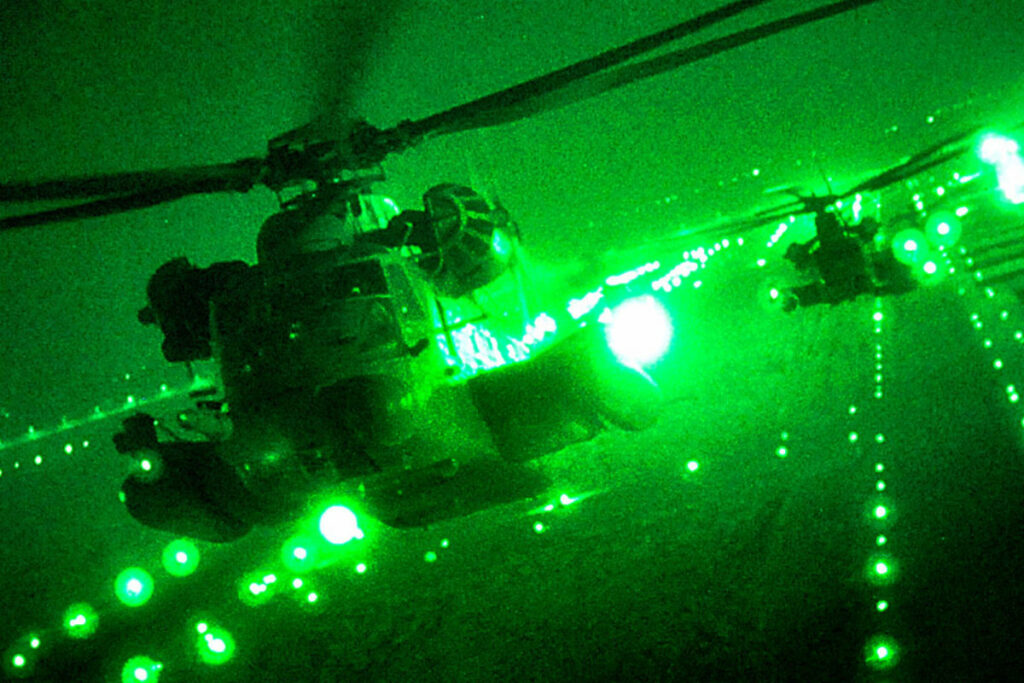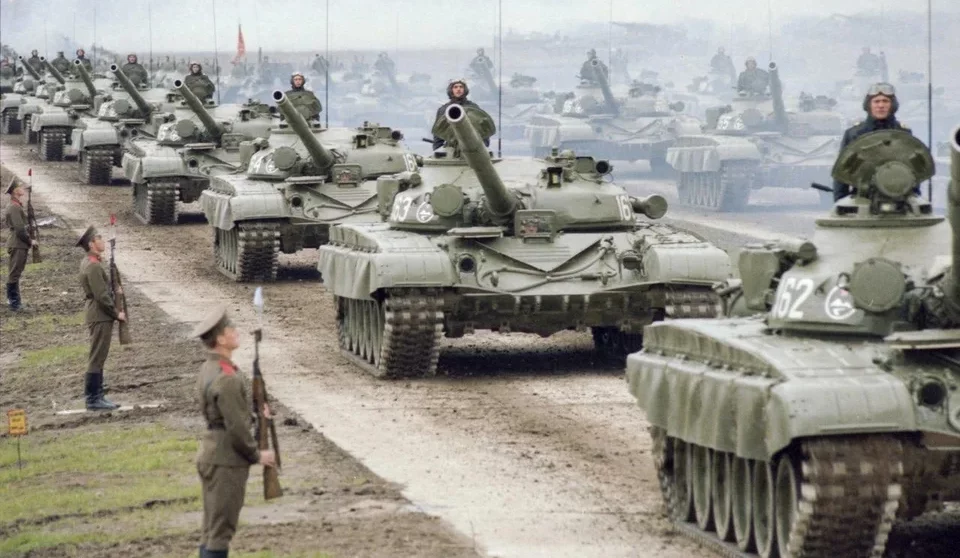Task Force Normandy and the first strikes of Desert Storm
- By Coffee or Die
Share This Article

This article by Matt Fratus was originally published by Coffee or Die.
US Army Lt. Tom Drew had his night vision goggles on while in the cockpit of his AH-64 Apache attack helicopter. It was 2:38 a.m. on the moonless night of Jan. 17, 1991. For the past two hours Task Force Normandy — a joint Army-Air Force strike team consisting of a dozen helicopters — had penetrated Iraqi airspace flying at nap-of-the-Earth altitude just 50 feet above the ground to avoid being detected by the targets they were sent in to destroy. The two-hour flight was completed under radio silence and total blackout of their navigation lights. On their final approach they identified two early-warning radar sites in the distance located about 435 miles inside Iraqi territory.
“Party in 10,” Drew gave the order over the radio.
Ten seconds after he spoke the command, eight AH-64 Apaches released their salvo of hellfire missiles to achieve 100% destruction against the electrical generators, communications facilities, and radar systems. In just four minutes, the Apaches fired 27 missiles, around a hundred 70 mm rockets, and some 4,000 rounds of 30 mm ammunition.

Related: Watch: Desert Storm’s air campaign was absolutely massive
The first Apache strike of Desert Storm, according to Gen. H. Norman Schwarzkopf, “plucked the eyes” of Iraq’s Soviet-supplied air defenses and opened a 20-mile-wide flight path for more than 900 coalition aircraft entering the aerial campaign.
“About five minutes into the flight back we could see the jets coming in right over our head,” Col. Richard A. Cody, the commander of the 1st Battalion, 101st Aviation Regiment, 101st Airborne Division, said. “That’s how the air war started.”
The secretive and successful operation that started the war wasn’t thrown together last minute; rather it was meticulously planned months in advance. After Iraqi dictator Saddam Hussein invaded Kuwait in August 1990, the US military immediately worked to emplace plans to strike strategic targets.
Related: Watch this F-16 pilot dodge six Iraqi surface-to-air missiles in Desert Storm
Initially there were three options on the table: one proposed using special operations forces (SOF) to insert and take out the sites with missiles, another suggested SOF elements could use handheld laser designators to mark the sites for an Apache attack, and the third called for the use of conventional Air Force fighter jets.
The strategic planners from CENTCOM, however, wanted to ensure the targets were destroyed without any friendly casualties on the ground as well as to not leave any doubts as to whether the bombs had done their job. The confidence of Cody and his Apache attack helicopter crews helped convince the brass that they could assess the damage in real time and deliver additional strikes if needed.
In September 1990, a helicopter assault package was approved. The flight crews were hand-picked and weren’t informed as to what the target was because of the secret nature of the mission. This joint force fell under Task Force Normandy and would be responsible for sneaking into Iraq undetected to knock out Iraq’s radar and ground-interception sites, despite having zero detailed maps and only limited intelligence.
They trained to limit risk and had multiple contingencies to address any problems. They trained at night in the desert, infiltrated denied airspace, completed six live-fire training exercises, and practiced target acquisition in simultaneous assaults.

“It would do no good to hit one radar site and, two minutes later, to hit another one,” Cody said. “We had to do it in such a way that we took down critical elements of those radar sites simultaneously so that Baghdad was not alerted to get [its] MiG-29s and ground-control intercept systems up.”
In order to accomplish this, Task Force Normandy was split into the White Team and the Red Team, each consisting of four AH-64 Apache attack helicopters and two MH-53J Pave Low electronic helicopters. The US Air Force’s Pave Lows from the 20th Special Operations Squadron were equipped with state-of-the-art terrain-following and global positioning systems that helped escort each team to their desired targets.
The final wrench thrown into the plan was removing an additional step for refueling. Instead of flying with a full combat load of eight Hellfire missiles, 38 rockets, and 1,200 chain-gun rounds, each AH-64 Apache reduced its number of rockets to 19.
“It initially appeared that I would have to use a Desert One type of refueling point,” Cody said. “But because of the complexity of the mission, because of the problems that could have been incurred by putting refueling systems that close to the border or actually inside the border, tipping the hand of what we were doing, we came up with the wing tank concept. It had never been done before. It raised the gross weight of the aircraft some 1,500 pounds past its combat weight. But it gave us a strike capability in excess of 400 miles.”
On Jan. 14, 1991, Task Force Normandy arrived at Al Jouf, a remote outpost near Saudi Arabia’s border with Iraq. Three days later, H-Hour came and Task Force Normandy would prove to be the best possible option to hit Hussein’s defenses before Iraqi forces had time to react.
Read more from Sandboxx News:
- SEALs going ‘back to the future’ in shift to near-peer warfare
- Female Air Commando at the helm of Special Operations wing
- First ‘grey berets’ graduate as special reconnaissance Airmen
- SEAL Team 6 parachute skills distinct among special ops units
- Watch: Australian Black hawk loses rotor blade during special operations exercise
Feature image: U.S. Air Force Special Operations Command
Related Posts
Sandboxx News Merch
-

‘AirPower’ Classic Hoodie
$46.00 – $48.00 Select options This product has multiple variants. The options may be chosen on the product page -

‘Sandboxx News’ Trucker Cap
$27.00 Select options This product has multiple variants. The options may be chosen on the product page -

F-35 ‘Lightning’ Framed Poster
$45.00 – $111.00 Select options This product has multiple variants. The options may be chosen on the product page
Coffee or Die
Coffee or Die Magazine is Black Rifle Coffee Company’s online news and lifestyle magazine. Launched in June 2018, the magazine covers stories both about and for the military, first responder, veteran, and coffee enthusiast communities.
Related to: Airpower, Special Operations

The US Army knows it has artillery problems. Now, it just needs to fix it

In 1980, the US Army feared Russian tanks were invincible

Breaking out of a POW camp on a Russian helicopter

This is how Navy SEALs conduct “over-the-beach” operations
Sandboxx News
-

‘Sandboxx News’ Trucker Cap
$27.00 Select options This product has multiple variants. The options may be chosen on the product page -

‘AirPower’ Classic Hoodie
$46.00 – $48.00 Select options This product has multiple variants. The options may be chosen on the product page -

‘AirPower’ Golf Rope Hat
$31.00 Select options This product has multiple variants. The options may be chosen on the product page -

‘Sandboxx News’ Dad Hat
$27.00 Select options This product has multiple variants. The options may be chosen on the product page
